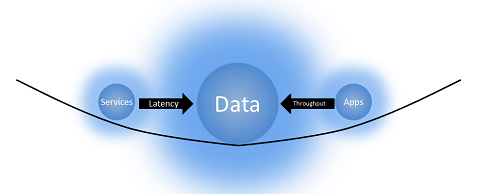
There are ideas and concepts that you come across that you realize immediately were not developed for your particular endeavor, but nonetheless are very appropriate. As physical security is becoming more oriented around industrial IoT, Big Data, machine learning, and other areas of data science there are some useful ideas for physical security professionals to consider. One of these is “data gravity”; the nature of large amounts of data to draw in applications and processes that take advantage of the presence of that data. If you’re running an IP-based physical security system, you may have already noticed that whether it’s a PSIM (physical security information management), Viakoo for automated system verification, or numerous advanced video analytics applications, there are now a lot more applications being drawn towards the data present in IP-based physical security systems.
According to Techopedia, “Data gravity is an analogy of the nature of data and its ability to attract additional applications and services. The Law of Gravity states that the attraction between objects is directly proportional to their weight (or mass). Dave McCrory coined the term data gravity to describe the phenomenon in which the number or quantity and the speed at which services, applications, and even customers are attracted to data increases as the mass of the data also increases.” Physical security is changing, and specifically in terms of how data is attracting useful applications.
What is motivating both end users and integrators to look at their systems from a perspective of data being generated (and how to best use that data)? There really are many reasons. The ability to predict when a camera device or disk drive is about to go bad can reduce costs and ensure no video evidence is missed. Knowing about traffic usage over time on your physical security network is useful to detect when that network has been taken over by cyber-criminals. Combining location information, temperature data, and camera uptime might show that those cameras in unheated places are offline more than they should during record cold snaps. In these and cases, using automation and analytics decreases risks, improves efficiency, and frees up human resources.
A visible example of such was Amazon’s recent announcement of their Amazon Go stores, which allows people to shop without having to use a checkout. In order to manage such an operation, Amazon turned to a massive number of surveillance cameras. This focus on data gathering in a retail operation makes a lot of sense. In real time inventory levels can be assessed and dealt with. People restocking shelves can have their tasks laid out in the most efficient way. How long people spend in front of certain displays (thinking of you, soup aisle), where their head turns, what promotions get noticed (and which ones don’t)….these examples and more show that there are many ways, once you have the data, to make meaningful and profitable use from it.
While it may seem like we’re in the early stages of using physical security system data to improve security, we’re really not. Viakoo customers have been benefiting from this revolution for a few years, and we often come across physical security professionals actively using data and analytics. Ready to get started? An easy way is with a demo account from Viakoo – you can sign up for one at www.viakoo.com/start. If you’re planning to be at ISC West in April, stop by the Viakoo booth and share your experiences with our physical security experts. We’re hoping the “gravity” of these matters draw you in!






